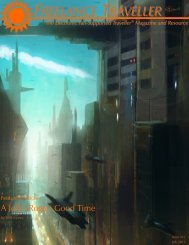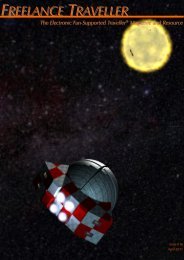Doing It My Way - Freelance Traveller
Doing It My Way - Freelance Traveller
Doing It My Way - Freelance Traveller
You also want an ePaper? Increase the reach of your titles
YUMPU automatically turns print PDFs into web optimized ePapers that Google loves.
<strong>Doing</strong> <strong>It</strong> <strong>My</strong> <strong>Way</strong><br />
(Continued from page 21)<br />
Data stores carry information about all individuals<br />
the user interacts with, as well as security<br />
permissions that can automatically open doors and<br />
start vehicles that the user has a legal right to open.<br />
The data store also holds all personal records including<br />
financial data, as well as the user‘s entire<br />
library of text, music, video, and holo-recordings,<br />
as well as any other data the user feels the need to<br />
keep with them.<br />
Data stores can communicate with devices<br />
other than hand computers, enabling the user to put<br />
on a pair of headphones that can then automatically<br />
access all music recorded in their data store, just as<br />
the user could give a multimedia presentation just<br />
by talking to a high-end holo-projector that communicates<br />
with the user‘s data store. Users need<br />
only verbally instruct devices to access specific<br />
contents from their data stores. Careful users require<br />
matching voice prints and passwords to access<br />
especially secure information. Data stores can<br />
be used for official verification purposes, storing<br />
voiceprints of known individuals and providing<br />
encrypted digital signatures for the user.<br />
At TL 10, a data store holds 100 TB, which<br />
most sophonts regard as barely adequate. Most<br />
travelers who can gain access to them use TL 12<br />
data stores, which contain 1 million times more<br />
data and are sufficiently large that even a longlived<br />
sophont cannot usually fill it up with all data<br />
they accumulate in their lifetime. Almost all inhabitants<br />
of TL 10+ worlds have data stores, and<br />
on TL 11+ worlds, it‘s difficult to function without<br />
one.<br />
Cost: Cr 100<br />
Display Glasses (TL 10): Looking much like<br />
ordinary eye glasses, this device contains tiny projectors<br />
in the temple pieces that project images on<br />
the inside of the lenses, allowing the user to see<br />
displayed images as if they were viewed on a large<br />
screen at a comfortable viewing distance. The user<br />
can either render the lenses opaque for clear viewing<br />
of entertainment or they can make the lenses<br />
fully transparent to allow for either discrete data<br />
display or various augmented reality applications.<br />
All display glasses also contain speakers in the ear<br />
pieces as well as a tiny front-facing camera and<br />
microphone for both augmented reality applications<br />
and for making discrete recordings. Display<br />
glasses also serve as variable tint sunglasses.<br />
Cost: Cr 100<br />
Wearable Interface (TL 10+): This device<br />
represents the typical ―hand computer‖ for many<br />
TL10+ societies and possesses all the capabilities<br />
of a standard hand computer, including the same<br />
statistics for the unit‘s computer. The TL 10 version<br />
consists of a small computer that is an oval 6<br />
cm x 4 cm x 1 cm. <strong>It</strong> is radio linked to a pair of display<br />
glasses (see above) and also includes a microprojector<br />
that can project clear images on any surface.<br />
Input comes through spoken or subvocalized<br />
commands. Thin gloves that can be used to provide<br />
gestural inputs, and on some units, electrodes on<br />
the user‘s scalp provide all non-verbal input.<br />
These electrodes can be worn on lightweight and<br />
often decorative headgear, or occasionally implanted<br />
just beneath the user‘s scalp, between the<br />
scalp and the skull. Some units also include display<br />
viewers that provide the user with enhanced vision<br />
and a small belt or other wearable device that provides<br />
the user with an innate sense of direction.<br />
Cost: Cr 1,500 (Cr 2,500 with implanted electrodes)<br />
At TL 11+, wearable interfaces can instead use<br />
contact lens displays and camera jewelry (see below).<br />
Most of these advanced rigs use subvocalized<br />
vocal input and scalp electrodes that are either<br />
worn on a headset or implanted.<br />
Cost: Cr 2,000 (Cr 3,000 with implanted electrodes)<br />
At TL 13+ the computer in this device can be<br />
made using a limited amount of synaptic circuitry<br />
and possesses the Low Autonomous command<br />
logic and Full Command fundamental command<br />
program, allowing it to understand relatively complex<br />
ordinary speech and make basic inferences.<br />
Cost: Cr 3,500 (Cr 4,000 for a contact lens display<br />
wearable interface, Cr 5,000 with implanted<br />
electrodes)<br />
Rules: The user can access data, communicate<br />
with other wearable interface users, and perform<br />
(Continued on page 23)<br />
22

















